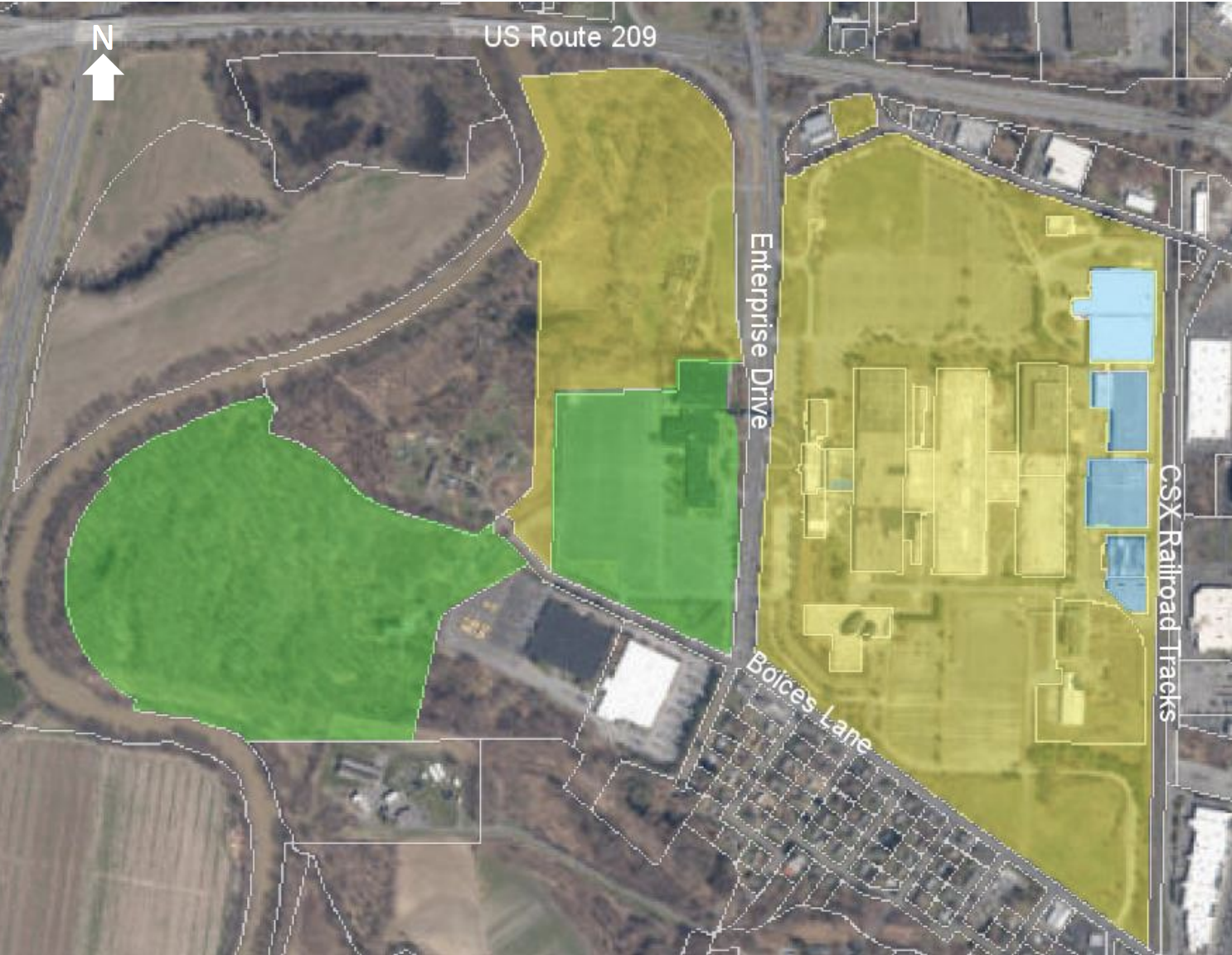FAQS - Tech City Proposed Purchase (FAQS provided by Ulster County Govt)
Last Updated 12/8/2021
Q1: What is TechCity?
TechCity is the name given to the former IBM campus in the Town of Ulster upon its sale by IBM to Alan Ginsberg and his related companies in 1998, following the closure of IBM’s Kingston-area operations. In the past 18 months, portions of TechCity have been sold or transferred, including 82+/- acres on two parcels west of Enterprise Drive that were acquired by the County through a previous foreclosure action and six parcels along the CSX tracks on the eastern edge of the campus that were purchased by a clothing wholesaler/distributor in August.
A map of the former IBM campus, including the remaining TechCity parcels that are proposed for purchase and redevelopment by National Resources, is available to view/download by clicking here.
Q2: What is being proposed for the TechCity properties?
In July 2021, Ulster County filed a foreclosure proceeding in Ulster County Court, due to unpaid taxes on the remaining TechCity parcels.
On December 1, 2021, Ulster County Court Judge Bryan Rounds signed an Order and Stipulation of Settlement that describes the terms by which the County and the owner of TechCity would settle the foreclosure proceedings and National Resources would purchase the remaining TechCity properties, complete environmental cleanup and redevelop the site.
On December 2, 2021, the Ulster County Legislature voted unanimously to authorize the County to accept deeds for the remaining TechCity properties in lieu of foreclosure. The Legislature also voted unanimously to set a public hearing on December 21, 2021 at 6:30pm, at which point the public is invited to provide comments via phone at 205-857-8370 about the proposed transfer of the remaining TechCity properties. Email comments may also be submitted to the Clerk of the Legislature at vfab@co.ulster.ny.us until December 21st.
Q3: Who is National Resources?
National Resources is a real estate investment company based in Greenwich, CT that has been redeveloping complicated former industrial sites in the metro-NYC area for over 30 years. Headed by Joseph Cotter, President and Lynn Ward, Executive Vice President, the firm’s entities currently own over $1 billion of projects in development in the New York metro area comprising over 3 million square feet of commercial property and 1,200 waterfront residential units. National Resources is the largest private owner of Hudson River waterfront property in the New York metro area, with 1½ miles of shoreline. The firm includes 75 professionals, including in-house engineering, legal and planning professionals.
According to the firm’s marketing materials, the success ingredient for National Resources over the years has been its ability to stay a step ahead of emerging real estate trends. This was evidenced in its founding in 1988, when it became one of the first groups to redevelop former industrial and environmentally-challenged sites. National Resources has been a pioneer of sustainability since it raised one of the first funds to take advantage of the “brownfield” opportunity in 1996, which was used to embark on some of the larger environmental cleanup and redevelopment projects in the region.
Q4: How was National Resources selected to purchase TechCity?
TechCity is not County-owned or controlled, so National Resources has not been chosen by the County to redevelop the site. Instead, National Resources has negotiated a purchase of TechCity from its current owner, Alan Ginsberg. Since the County has already begun a foreclosure process, and since the combined costs of environmental work, back taxes and other liabilities on the site exceed the likely value of the properties, National Resources approached the County to facilitate the purchase.
Q5: What is National Resources proposing for the former IBM campus?
National Resources has provided an overview of their proposed plan for redevelopment of TechCity as a submission to a Request for Expressions of Interest (RFEI) that was issued by the Ulster County Economic Development Alliance in September. That overview is available to download/view by clicking here. National Resources has also indicated that they intend to develop the site in a manner that is consistent with a 2009 master plan that was developed for the site in collaboration with the Town of Ulster. That master plan is available on the Town of Ulster’s website, or by clicking here.
Q6: How was the purchase price of $12 million determined?
The County is in the process of foreclosing on these properties and has high confidence that the foreclosure will eventually be successful, although the process could take years. The purpose of a County foreclosure is to recoup the unpaid taxes on a property or properties. In this case, the combined amount of unpaid taxes owed on the TechCity parcels that National Resources proposes to purchase is approximately $12,000,000. Hence the $12,000,000 purchase price - if a buyer can pay that amount to the County now, it saves years of delays, legal bills, continued accumulation of unpaid taxes and deterioration of the site.
This purchase price is not the full cost of buying the property. In addition, the buyer will be responsible for an estimated $7-12 million of future environmental cleanup costs, $640,000 of payments to EPA for cleanup work already completed, plus hundreds of thousands of dollars in unpaid bills and fees. Furthermore, the buyer will be responsible to pay taxes going forward, which saves the County around $500,000 per year it currently pays even to the Kingston School District and Town of Ulster, when the current owner fails to pay taxes.
Q7: Why is National Resources receiving a credit toward the purchase price?
Whoever purchases the TechCity properties automatically takes on a number of other significant costs: cleaning up the debris piles on the site, settling any unpaid utility bills, assessing and fixing the deteriorating condition of existing buildings, managing existing tenants and paying future tax bills. When you add up all those costs, the property is considered to be “underwater” - the amount of money owed for these costs likely exceeds the value of the property. Normally, a property with these liabilities would continue to sit and deteriorate until either the liabilities are reduced or the value of the property increases.
Since the successful redevelopment of the site would have significant public benefits - both through remediation of environmental hazards and blighted conditions, and the creation of new jobs and economic activity - there is a justification for trading off some of the taxes owed in exchange for the successful redevelopment of the site.
In exchange for completing the clean up, which is estimated by EPA to cost in excess of $7,000,000, the County is willing to provide a credit of up to $7,000,000 toward the purchase price. This provides $12,000,000 in value to the County as a combination of cash payments and payments to clean up the site, which - once completed - enables further development of the site that is expected to generate over $200,000,000 in future investment and up to 1,000 new jobs.
Q8: What is the basis for the estimated cost of environmental cleanup of the site?
While the large, covered asbestos-containing debris piles at Tech-City may be the most familiar sign of the botched demolition and asbestos remediation job undertaken at the site in 2015/2016, the action also left behind massive amounts of severely damaged and dangerous asbestos inside of what are known as buildings 1 and 2 at the site. The piles and two buildings were the subject of a 2020 federal Environmental Protection Agency (“EPA”) action against site owner Alan Ginsberg, his companies, and the companies and individuals responsible for the botched demolition / asbestos abatement. Subsequently, and pursuant to the EPA’s action, an asbestos remediation contractor estimated removal and disposal of the 18,000-ton debris piles alone to be a $3 million project. A full assessment of building 1, which is the size of about six football fields, has yet to be completed, including an attempt to determine whether the building must be fully abated and then demolished removed or if the asbestos can be abated and the building repaired and put back into reuse. The EPA has preliminarily estimated that building 1’s remediation could cost anywhere from $4 million to well over $6 million, depending on the results of an assessment. The far smaller building 2 was properly demolished and disposed of off-site by EPA contractors in 2020 at a cost to the federal government of more than $200,000.
Q9: Will National Resources pay future taxes on the properties? Are they seeking a PILOT?
Once the purchase is complete, National Resources will be responsible to pay property taxes on the property based on its assessed value, which is set by the Town assessor. National Resources has agreed not to seek a PILOT for the purposes of acquiring the property, though it reserves the right to seek PILOTs and other incentives to the extent such incentives are necessary for future phases of redevelopment at the site.
Q10: When will the cleanup begin?
Once the purchase is completed, National Resources must enter into an agreement with EPA prior to undertaking clean up activities. It is expected that the cleanup will begin within six months after the purchase is completed. The debris piles are expected to be removed within 12 months after purchase, and Building 1 is expected to be remediated and stabilized within 24 months after purchase.

